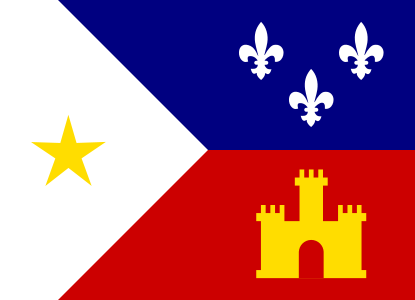
|
Acadian Arrival in Louisiana |
|
|
Contents
1) Acadian Arrival in Louisiana2) Louisiane Acadian Settlement Regions
3) St. Jacques de Cabahannocé - Côte aux Acadiens Region
4) Attakapas Region
5) Acadians caught in the Spanish possession of the territory and the 1768 rebellion
Acadian Arrival in Louisiana
|
As the Acadian exiles in the middle and southern colonies began to gravitate towards the former French colony of Louisiana, an alliance, known as the 1761 Pacte de Famille or (Family Compact) had recently been agreed upon by the monarchies of the maison de Bourbon, French King Louis XV and Spanish King Charles (Carlos) III. There were three treaties that were known as the pactes de familles or family compact:
1) treaty of the Escorial of 7 November 1733
|
|
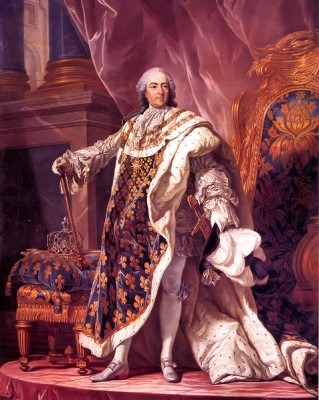
|
||||
Near the close of the Seven Years War, known in North America as the French and Indian War due to the French and British conflicts fought in the North American theater, Louis XV realized that an alliance between France and Spain would help to solidify opposition against Great Britain. The alliance was to be the last of the "Pacte de Famille" alliances. The third of Pacte de Famille alliance was signed on August 15, 1761 and was known as the precusor of the "Treaty of Paris". The actual transfer of the Louisiane territory to Spain took place prior to the Treaty of Paris in "The Treaty of Fontainebleau", signed on November 13, 1762.

|
|
As the Seven Years War began to come to a close, King Louis XV was faced with the reality of territorial losses. Rather than risk loosing the Louisiane territory to Great Britain, King Louis XV proposed the sucession of the Louisiane territory to his cousin, Spanish King Charles (Carlos) III. The transfer of the Louisiane territory took place on November 13, 1762 as of the signing of "The Treaty of Fontainebleau". |
||
On April 4, 1762, King Louis XV sent a letter to the captain of the colonial troops in the Louisiane territory, Charles Philippe Aubry. In it King Louis stated:
Hoping, moreover, that His Catholic Majesty will be pleased to give his subjects of Louisiana the marks of protection and good will which only the misfortunes of war have prevented from being more effectual.
Louisiane Acadian Settlement Regions
The Acadians are historically responsible for settling the southeast and southwest regions of Louisiana beginning with the Côte de Acadiens and Attakapas areas. This is a direct result of the Acadian's desire to re-establish themselves with lost family members who where torn apart during the Le Grand Dérangement and the Spanish government offering of land grants.
Many of the Acadians who were exiled to the colonies of Maryland, Pennsylvania, Virginia, South Carolina, Massachusetts, France and England found refuge on the banks of the Mississippi River at present day St. James Parish (the first Acadian Coast), St. Gabriel and Iberville Parishes, and the Attakapas Region at present day St. Martinville primarily in the years 1764 - 1768. Acadian arrivals came to a hault at the end of 1768 and began again with the ships sailing from France in 1785. Many of the Acadians on the 1785 ships settled near the LaFourche (the fork), St. Gabriel, Attakapas, Manchac and Baton Rouge areas of Louisiana.
Côte aux Acadiens Region
The first Acadian, Mississippi River settlements, became known as the Acadian Coast. The territory, then was known as "St. Jacques de Cabohannocé" (see the pictures on the First Acadian Church Communities page). More land began to be appointed by the Spanish government upriver towards St. Gabriel in Iberville Parish, Donaldsonville and Ascension Parish as the Acadians kept venturing to their new land. This land upriver became know as the second Acadian Coast. The majority of Acadians who settled in the first and second Acadian Coasts were from group were from the Cobequid, Minas, and Pisiquid areas of l'Acadie, Nova Scotia.
A number of exiled Acadians who settled on the 1st Acadian Coast arrived at the Côte de Acadiens escaping the Le Grand Derangement in the years 1756 - 1757. Although it is thought that a small group of Acadians arrived in Louisiana in those years, the first officially documented Louisiana arrival of Acadians exiled in Le Grand Derangement settled in St. Jacques de Cabahannocé, Attakapas and St. Gabriel between the years 1764 and 1768. The majority of these groups of Acadians had spent a decade or more in imprisonment and exile, primarily from Maryland and other New England states beginning in November, 1755.
The majority of the Mélançon/Melanson exiled in Le Grand Derangement arrived in the St. Jacques de Cabahannocé and Attakapas regions of Louisiana between 1764 and the end of 1766.
"The first colony was founded on the Mississippi itself near Baton Rouge ; but those who came to join them pushed their settlements into the interior to the Attakapas and Opelousas, where they formed important and prosperous groups. There they have devoted their attention chiefly to the raising of cattle in large herds ; they have preserved their customs, traditions and language with a fidelity that makes them recognizable at sight."
source:
ACADIA: MISSING LINKS OF A CHAPTER IN AMERICAN HISTORY. Richard, Édouard, 1844-1904 EX-MEMBER OF THE HOUSE OF COMMONS OF CANADA; VOL. II,
NEW YORK HOME BOOK COMPANY MONTREAL; JOHN LOVELL & SON
Attakapas Region
The region comprised the territory now forming St. Martin, St. Landry, Iberia, Lafayette, Acadia, Vermilion, and St. Mary parishes. It was bounded on the north by the Avoyelles District, on the east by the Atchafalaya River and Grand Lake, on the south by the Gulf of Mexico, and on the west by the Mermentau River and the chain of lakes through which it flows.
The district was named for the Attakapas Indians who could be found in the western part of what is now Iberia Parish. An old Indian trail ran from what is now Lake Charles, to present-day New Iberia, and then to today's Morgan City.
Approximately 193 Acadians who had been involved in guerilla warfare against the British in Canada were led by Joseph Broussard dit Beausoleil to settle in the Attakapas Territory in 1765. In 1778, about 500 French people were sent into the Attakapas District by Gov. Bernardo de Galvez. They first settled primarily in what would become St. Martin Parish. But they were soon followed by Spaniards who would found Nueva Iberia and would move out into the countryside from there.
After the Louisiana purchase, Attakapas County was created from the Attakapas and Opelousas districts in 1805 by Governor William C. C. Claiborne. In 1811, the county was divided into the parishes of St. Martin and St. Mary. The region was further subdivided in 1823, 1844, and 1868 to create Lafayette, Vermillion, and Iberia parishes.
Acadians caught in the Spanish possession of the territory and the 1768 rebellion
On Sept. 28, 1766, 224 Acadians arrived from Snow Hill, Maryland.
Antonio D'Ulloa, Governor of Louisiana, writes to Jeronimo Grimaldi, the Spanish Ambassador to France describing the 28 Sept. 1766 arrival of a group of Acadians from Maryland:
New Orleans, September 29, 1766
"An English sloop carrying the French Acadian families
arrived here on the twenty-eight. After a voyage of three
months-since June 26, when it departed Maryland, New England-it brought
224 men, women, and children, 150 in the last two categories. During
the voyage fourteen died and three (others died) after they had (arrived
at Balise at the mouth of the Mississippi River) and obtained some
provisions. Three of them were born during the trip and two more
have died (while the ship sailed upriver to New Orleans). Because
these people arrived in misery and in great need, they were helped
immediately, by order of the French general (Charles-Philippe Aubry) and
myself,... given drinks and biscuits which had been reserved for the first
needy who might arrive; I also gave them a bull and a calf, which I had
brought from up-river for consumption by myself and my companions. I
did so the same night in which the boat carrying them was
discovered. The shipmaster assured me that as soon as they received
the animals, they killed them and ate the meat raw. The sloop
continued upstream until it joined the boats that had been summoned... so
that they could be transferred and then taken to New Orleans.
The arrival of these people, together with those of the
same nationality who are already here and with those who may come, is a
source of great embarrassment for me, as it would be for any other ruler,
because as soon as they arrived, we must spend money on them, give them
what they need, and continue doing so until they have a way to support
themselves, which requires at least two years. To settle them we
must provide them with arms and ammunition, tools, etc. Widows and
orphans have to be furnished everything, and all of them need a physician
, medicines and food. In the first two years after their arrival,
many fall sick and the number of deaths is large, as is the case now, and
having no orders from His Majesty, we do not know what to do: On one
one hand, we are motivated by charity and obligation to hospitality,
because if they are not helped, they will inevitably die; and , on the
other, we are duty-bound not to use money for ends that are not authorized
by royal decree, so we are uncertain about what course to
take.
My thoughts on this matter always lead to the conclusion
that I previously explained to Your Excellence. If it is His
Majesty's desire to preserve the colony as a buffer for the kingdoms of
New Spain, because he considers it advantageous or the surest means of safeguarding
them, without expecting any kind of profit, now or later, then it should
be populated, and, to do this, it is necessary to spend large sums and to
do so immediately...
"
Quest for the Promised Land: Official Correspondence Relating to the First Acadian Migration to Louisiana, 1764-1769. Lafayette, La.: Center for Louisiana Studies, 1989.; Brasseaux, Carl A., Emilio Fabian Garcia, and Jacqueline K. Voorhies, trans. and eds.
This group was settled along the Acadian Coast in St. James and Ascension Parishes.
The next group of Acadians arrived from the port of Baltimore, Maryland on about 18 November, 1766, aboard the ship "VIRGIN" (Captain Tirel, skipper). Another group of approximately 689 Acadians from Maryland and Pennsylvania chartered local merchant vessels to take them to Louisiana. After a 78 day voyage, they arrived on July 12, 1767. They wanted to settle with their family members and friends at Cabanocey, but Governor Ulloa sent them to St Gabriel on Bayou Manchac to strengthen the area against English invasion.
After being exiled from their homeland in 1755, spending 7 years in captivity at the hands of the British, many Acadian refugees had been finally given the hope of being reunited with family in what they thought was French controlled Louisiana. Many Acadians arriving in Louisiana during this period began to wake up to other harsh realities: Louisiana was now controlled by Spanish authorities, and the Spanish governor was more concerned with strengthening the region against British invasion than to reunite Acadian immigrants with their exiled family members.
The settlements in Louisiana rose up in rebellion against the Spanish authorities, namely Governor Ulloa, in 1768. There were many reasons for the uprising. It involved French settlers in the New Orleans area, German settlers from the German Coast area and Acadian settlers from the Acadian Coast and Natchez areas. Although the rebellion was not instigated by angered Acadians, many joined the rebellion. The fact that Governor Ulloa disallowed Acadian immigrants to be reunited with family members did not help with his popularity among their trenches and provided them with an oppurtunity to move closer to their families.
In the summer of 1768, Ulloa announced plans to crack down on Louisiana's smuggling operations by closing the mouth of the Mississippi to only one channel to improve on security. At the same time, he also announced that Louisiana would no longer trade with France or any of its colonies, consistent with a policy in other Spanish possessions. In the fall of 1768, Denis-Nicolas Foucault, who was the Commissary for Louisiana under the French, and had continued the position under the Spanish during the transition, and Nicolas Chauvin de La Freniere, who was the Louisiana attorney general under the French and also continuing under the Spanish, hatched a plot to force the governor out. On October 28, as riots broke out in New Orleans, the senior military officer in the colony, Captain Charles Philippe Aubry, a French officer, escorted the governor and his pregnant wife to a Spanish vessel. The Superior Council voted that the governor leave within three days. He complied, leaving on November 1.
Mélançon / Melanson
On Sept. 28, 1766, 224 Acadians arrived from Snow Hill, Maryland. Osite (Ozitte) Hébert Melanson, who had recently been widowed by the death of her husband, Alexandre Minquion Melanson, the son of Jean Dominique Melanson & Marguerite DUGAS of Grand-Pré, exiled to Maryland in 1755, arrived on this ship with the remainer of her surviving family.
Listed in the St. Jacques de Cabahannocé census, 1769, the census stated that she was at that time occupying lot number 122, on east bank of the Mississippi.
The census identified the family as:
Ozitte Hébert widow Mélançon, age 39, with sons Pierre Mélançon age 9, Joseph Mélançon age 15, Étienne Mélançon age 13 (picked for the Galvez Expedition by Galvez himself, married Ludivine Braud in 1780 but died in 1788), Paul Mélançon age 7 (our family's direct line), & Charles Mélançon, age 17 months.
ETIENNE(ESTEVAN)3Mélançon
(ALEXANDRE2, JEAN DOMINIQUE1) was born abt. 1756 in Snowhill, Worchester, Maryland, and died Bef. January 20, 1789.
He married LUDOVINNE BRAUX(BREAU)April 14, 1780 in St. James Church, St. James Parish, Louisiana1, daughter of CHARLES
BREAU and MARIE BENOIT. She was born 1759, and died January 24, 1856.
Notes for ETIENNE(ESTEVAN) Mélançon:
Following is a transcript of an arcticle originally published in Les Voyageurs, June 2000, submitted by Jean Marie Louviere Cambre:
Etienne Mélançon was the middle child of Acadian parents, Alexandre Mélançon and Ozite Hebert. He was born circa 1756 in Maryland; his name first appeared on the September 14, 1759 census of the First Acadian Coast of Louisiana. The list shows
him on the East Bank of the Mississippi River, living with his widowed mother and his four brothers: Pierre-Jacques, Joseph, Paul and Charles. On the January 1, 1777 Census he is listed as 20 years old, still living with his mother and three of his brothers. The oldest brother, Pierre-Jacques, is now married and living with his wife, Elizabeth Landry, and their children.
From the 1777 census, General de Bernardo Galvez compiled the names of men he wanted to fight with him in the 1779 war against the English-held forts along the Lower Mississippi Valley. (He only requested young unencumbered bachelors for this mission.) He chose Etienne, 22, over the oldest boy at home (Joseph, age 24) perhaps incorrectly assuming Joseph was the eldest son. For whatever reason, is was Etienne Mélançon whose name was on the list sent to Commandante Cantrelle of Cabahanocey (St. James Parish). Because his name was on the list made by Galvez himself, he has been proclaimed a Patriot for the Revolution.
Shortly after freeing control of the Mississippi Valley from the English, Etienne Mélançon, at age 24, married a girl born of Acadian parents like his own. Her name was Ludivine Braud, She was also born in Maryland where her family was brought on an English ship from Acadia."
More About LUDOVINNE BRAUX(BREAU):
Burial: St Michael's Cemetery, Convent, Louisiana
Personal Note: My father and I found her grave at St Michael's Cemetery, Convent, Louisiana one early morning while searching for her brother-in-law and our direct ancestor, Paul Oliver Mélançon.
Since the tombs and graves at St. Michaels (Click here for The First Acadian Coast Cemeteries Page) date to the 1750's era, some are in horrifying condition due to movements of the Mississippi River and age. Paul's grave appears to be either one of the one's in horrifying condition, or it was lost to the river.
Paul and Ludivine are listed together as sponsors and witnesses in many of the church ceremonies listed in the Diocese of Baton Rouge Catholic Church Records volumes. They participated together in many functions. Finding her grave in such good condition helped to console us with that fact that we may never be able to locate his grave. - see below
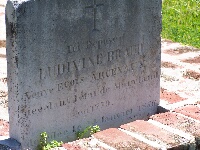
|
|
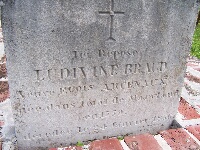
|
||||
| These are very recent pictures |
|
Her headstone and grave are in wonderful condition. | ||||
|
le français -
Ici Repose LUDIVINE BRAUD Neuve Fcois ARCENAUX nee dans letat de Maryland en1756 decedee le 24 Janvier 1856 |
|
en english -
Here Rests LUDIVINE BRAUD New France ARCENAUX born in the state of Maryland in 1756 deceased on 24 January 1856 |
||||
sources:
Post, Lauren C. Some Notes on the Attakapas Indians of Southwest Louisiana. Louisiana History: The Journal of the Louisiana Historical Association, Vol. 3, No. 3 (Summer, 1962), pp. 221-242.
History of Louisiana, Vol. II, Ch. 2 thru Vol. III, ch. 1 (q.v.).; Charles Gayarréa
Brasseaux, Carl A. The Founding of New Acadia: The Beginnings of Acadian Life in Louisiana, 1765-1803. Baton Rouge, 1987: Louisiana State University
Jobb, Dean. The Cajuns: A People's Story of Exile and Triumph. Hoboken, NJ, 2005: John Wiley and Sons.
HISTORICAL MEMOIRS FROM THE FIRST SETTLEMENT OF THE COLONY TO THOUGH DEPARTURE OF GOVERNOR O'REILLY IN 1770, FORMING THE FIFTH OF THE SERIES OF HISTORIC AT, COLLECTIONS OF LOUISIANA, B. F. FRENCH, NEW-YORK; LAMPORT, BLAKEMAN & LAW, No. 8 PARK-PLACE, 1853.
Griffin, Harry Lewis. "The Attakapas Country: A History of Lafayette Parish, Louisiana". Pelican Publishing, 1959
Rieder, Milton P. Jr. & Rieder, Norma Gaudet, The Crew & Passenger Registration Lists of the Seven Acadian Expeditions of 1785 (Milton P. Rieder, Jr. and Norma Gaudet Rieder; Metairie, LA; 1965)
The Deportation of the Acadians. 1986, Publication of the Minister of Supply and Services, Canada.
Acadian Families Who Want to Go to Louisiana to Establish Themselves at the Expense of His Catholic Majesty (September, 1784; Spanish)
Original Record - Archivo General de Indias, ‘Audiencia De Santa Domingo’ (A.D.S.) (Seville, Spain) - Legajo 2575 (Microfilm copy at University of Louisiana in Lafayette; Lafayette, LA)
Descendants of Jean Dominique Mélançon
Acadians in Gray Website:
http://www.acadiansingray.com/Appendices-ATLAL-HEBERT.htm#Osite%20HEBERT
St. Jacques de Cabahannocé Census, 1769
Les Voyageurs, June 2000
Spanish Arrive in Louisiana: The Transformation from a French to a Spanish Colony by Anthony W. Fabio
Copyright © 2010 - All Rights Reserved - Louisiane Acadien / Acadian Melancon
Template by OS Templates
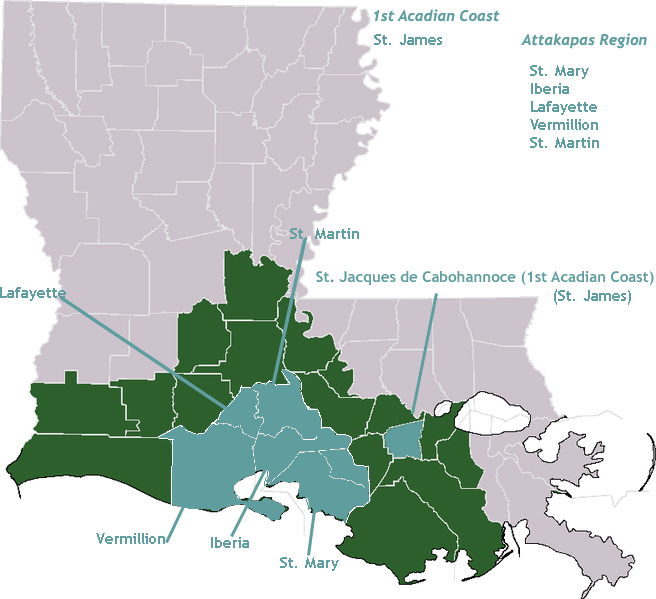
 yahoo.com
yahoo.com